|
Northrop YRB-94A
by Phil Brandt
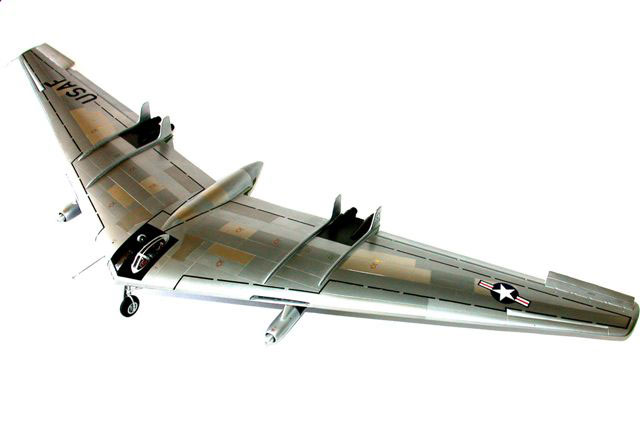 |
|
Lockheed YRB-94A |

HyperScale is proudly supported by
Squadron.com
The YRB-49A, Last of Jack
Northrop's Wings
The frail, eighty-four year old man had tears in his
eyes as a small box was opened at a highly classified 1980 ceremony in
Southern California. No matter that the emotional event was over thirty
years late; it was vindication of John K. Northrop's lifelong dream of a
viable flying wing, for in the box was a model of what would shortly
become the B-2 Stealth Bomber. Mr. Northrop died the following year, and
it is difficult to imagine anyone in aviation history who contributed
such an eclectic list of engineering innovations. Donald Douglas Sr.,
himself no small figure in world aviation, was quoted as saying that
every major airplane in the world had a piece of Jack Northrop in it.
The large Northrop flying wings were developed in the mid-to-late
Forties amidst the most feverish developmental burst in world aviation
history. One day's cutting edge technology would be quickly surpassed by
a blizzard of new discoveries and events. Compounding this technological
whirlwind, Air Force weapon system requirements seemed to change monthly
as Cold War reality engulfed the West.
Northrop was being pushed very hard in the marketplace; Boeing's B-47
and B-52 possessed superior overall performance, and Convair's slower
B-36 had range and impressive weightlifting ability. Unfortunately, the
many aerodynamic advantages of the flying wing concept were offset by
powerplant material failures. Developmental ceilings in piston engine
technology and propeller gearbox metallurgy had been reached, posing a
show-stopping impasse. Enter the jet engine.
 Eight-jet powered YB-49s were converted from the propeller-driven
XB-35s, ushering in a new era of power and smoothness. But, flight
instability in all three axes remained a serious obstacle to accurate
bombing, and autopilot technology of the time was inadequate to the
unique requirements of the big wings. Additionally, the Air Force
ratcheted up flight test rigors, which alarmed veteran Northrop test
pilots. These increased demands apparently culminated in the 1948
inflight disintegration and crash of the second YB-49 and the deaths of
Air Force test pilots Captain Glen Edwards and Major Daniel Forbes. The
final blow to the flying wing program came in 1950 when an unrecoverable
nosewheel shimmy led to the destruction of the remaining YB-49 in a
highspeed runway test. Eight-jet powered YB-49s were converted from the propeller-driven
XB-35s, ushering in a new era of power and smoothness. But, flight
instability in all three axes remained a serious obstacle to accurate
bombing, and autopilot technology of the time was inadequate to the
unique requirements of the big wings. Additionally, the Air Force
ratcheted up flight test rigors, which alarmed veteran Northrop test
pilots. These increased demands apparently culminated in the 1948
inflight disintegration and crash of the second YB-49 and the deaths of
Air Force test pilots Captain Glen Edwards and Major Daniel Forbes. The
final blow to the flying wing program came in 1950 when an unrecoverable
nosewheel shimmy led to the destruction of the remaining YB-49 in a
highspeed runway test.
Northrop's last glimmer of salvation was a one-off, six-engined
reconnaissance airframe, the YRB-49A. Although generally resembling
previous wings, it reflected lessons learned. The pilot and copilot now
sat in tandem, with a jettisonable canopy, and two of the six engines
were suspended on large pylons beneath the wing, allowing more fuel
space and providing needed directional stability. Flight test of this
final design ended in 1951 although the 'ballgame' had really been over
for the Northrop wings for a year. In 1952 a bitter, sick and
disillusioned Jack Northrop left the company which bore his name, and
soon his flying wings were gone, too. The last-of-the-line YRB-49A was
scrapped at Ontario Airport in 1953.
Conventional airframe design ruled for the next thirty years, until
Northrop designers Irv Waaland and John Cashen started with a clean
slate and the benefits of the Computer Age, not to mention that Jack
Northrop had already proven the feasibility of an all-wing design. When
the stealth requirements of modern day air warfare were factored in, the
advantages of a flying wing design resurfaced, with the traditional
instabilities inherent in the design now neatly solved by computers.
Amazingly, Waaland and Cashen independently arrived at a pure wing
configuration--minus stealth-destroying fins and fences--having the
exact wingspan of Jack Northrop's earlier design!
Jack Northrop has been deceased for over two decades at this writing,
but the sinister fleet of B-2 bombers at Whiteman AFB is a constant
reminder of this aviation pioneer's genius and foresight.
Although essentially having departed today's plastic
model aircraft market, AMT/Ertl's big plane releases were welcomed by
modelers for their risk-taking subjects. To date, it is the only company
who has done an injected 1/72 line of KC-135s and early flying wings.
I had acquired the prop-driven XB-35 kit, but desired
the one-off, last-of-the-line YRB-49A. Execuform to the rescue! Mike
Herrill's three-versions-in-one (XB-35/YB-49/YRB-49A) vacuform release
predates the AMT/Ertl kit by a few years but, of course, has all the
labor intensiveness of the vac genre, though, as Bondo has noted in an
earlier article, lack of engraving can be a plus. And, as far as I'm
concerned, the wonderful eighteen legal-sized pages of flying wing line
drawings are easily worth more than the plastic. These contain more
information than you'll ever need. All versions of the early wings are
covered, with cockpit and engine details not seen anywhere else by this
modeler.
The plan was to convert the prop-driven XB-35--the YB-49
kit version was not yet a reality--into the six-engined YRB, just as in
real life. From the Execuform vac I scavenged the radar/photo empennage
from the central pod , the jet intake trunks, the suspended
J-35s/pylons, the fin/fence assemblies and the tandem canopy.
Re-Engining's Got to be the
Hardest Thing...
All four engine nacelles and associated underwing
turbocharger intakes were cut out of the Ertl wing, and the openings
filled with sheet plastic and epoxy putty. Then, new twin jet exhausts
were scratchbuilt from Evergreen tubing and faired in to the wing
trailing edge, accompanied by lotsa Bondo's favorite 3M Blue Acryl
lacquer putty.
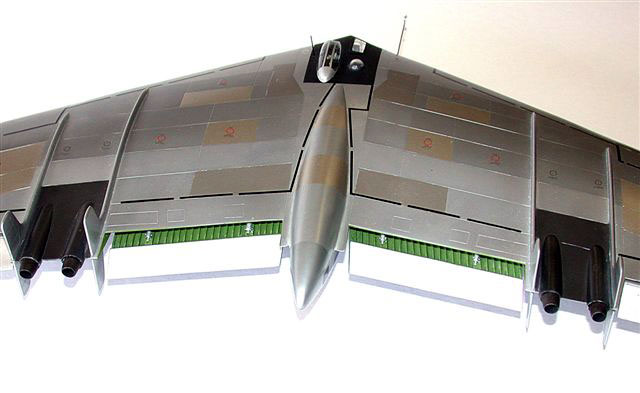
As the project moved ahead, Ertl released the eight jet
YB-49, and I elected to use the injected fin/fence assemblies from this
kit instead of the vacformed ones. An added plus was that the fin/fence
assemblies would exactly match the XB-35 wing contour.
All four vertical
fins and wing fences were removed from the new Ertl YB-49 wing and
relocated on either side of the YRB's twin jet exhausts in the following
manner: a Number 24 blade was used in multiple passes to score around
the fin/fence assemblies. Then, with needle nose pliers, the assemblies
were gently wiggled back and forth sideways until they popped off the
wing surface. After sanding the bottom surfaces the assemblies were
ready to glue onto the wing in their revised positions.
Intakes...Big Suckers!
The Ertl intakes are represented with a shallow (1/4")
blocked off depression in the wing leading edge. I decreased the width
of the intakes to that required for just two engines by filling in the
ends of the four-jet intake with A&B epoxy putty. When it cured, I
Dremmeled out the two-engine opening slot and adapted the vacuform
halves of the correct depth (2") Execuform intake trunks. The hardest
part was fairing in the interior trunk surfaces with puddled CA and
accelerator. Compressor blade faces were 'cannonballed' from the parts
pile.
Radar/Photo Pod
First the bulged, teardrop fairing adjacent to the XB's
aft pod was cut out and the resulting hole sheeted in. The entire aft
portion of the Execuform pod was separated from the vacuform wing. Then
the forward one inch of the surface to be joined to the injected Ertl
pod was scarfed, that is, thinned to a knife edge. The vacuform aft pod
was then slipped over the existing injected pod and glued. And, as
before, appropriate Blue Acryl blah, blah...
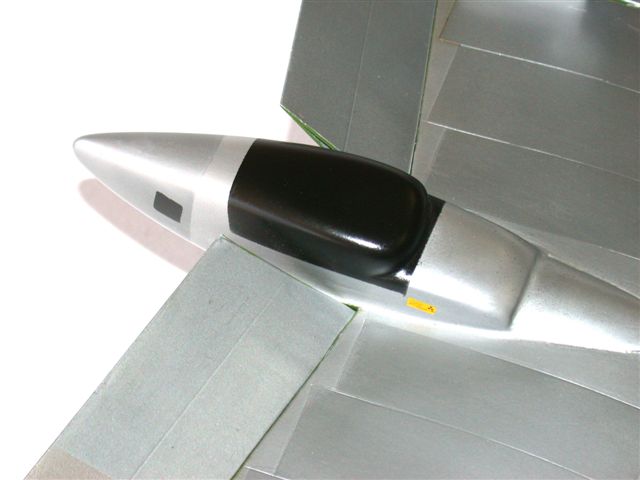
Jet Pods
These were used in toto from the Execuform kit
with spares box compressor and turbine faces added.

Cockpit and Canopy
Here the Execuform detail drawings were invaluable. The
side-by-side pilot seating was reconfigured to tandem, sticks
substituted for control columns and a scratchbuilt navigator position
added, with periscopic sight and forward oblique camera station.
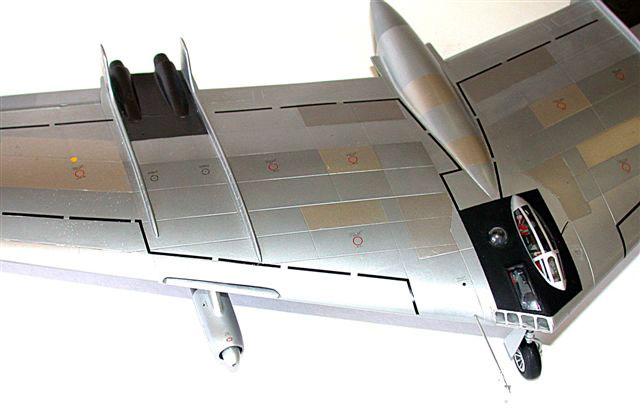
The Execuform canopy, thin and clear, was used as is.
Flaps and Rudders
Inner flaps were dropped and details scratchbuilt per
the Execuform drawings; ditto for the opened wingtip rudders.
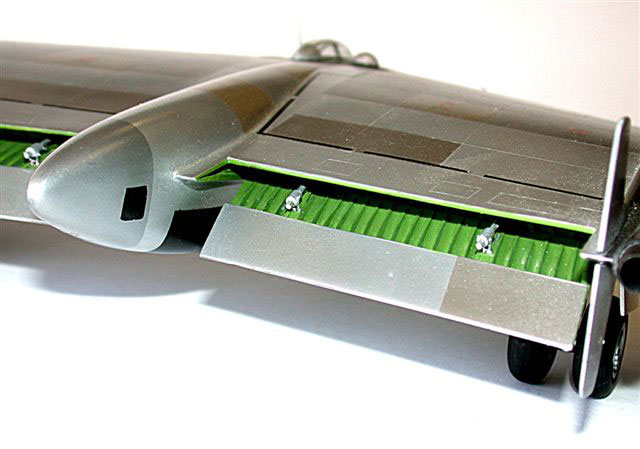
After even more Blue Acryl and lacquer primer, I
wet-sanded with 1000 grit, and started shooting four shades of original
acetone formula Alclad (Alclad II did not yet exist). The flying wings
were minimally marked, and I went to the spare decal repository to
locate the correct large and small serial numbers. The most
time-consuming task was applying the long black wingwalk stripes from a
Superscale sheet.
Once again, Mike Herrill's Execuform kits have come to
Bondo's rescue, saving untold hours of intensive 'practice bleeding'
labor in scratchbuilding conversion components. And, the huge sheaf of
superior line and detail drawings is in itself a valuable reference
'work' not to be missed.
Click
the thumbnails below to view larger images:
Model, Images and Article
Copyright © 2002 by Phil Brandt
Page Created 24 June, 2002
Last updated 04 June, 2007
Back to HyperScale
Main Page
Back to Features Page |
Home
| What's New |
Features |
Gallery |
Reviews |
Reference |
Forum |
Search